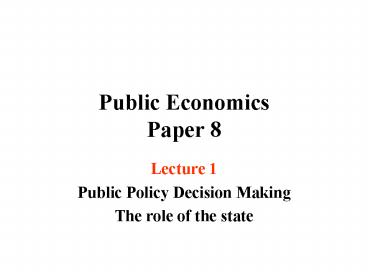Public Economics Paper 8 - PowerPoint PPT Presentation
1 / 23
Title:
Public Economics Paper 8
Description:
Ordinal or cardinal preference information? What is the form of the SWF? ... individual utility functions are cardinal and. interpersonal comparable. Argument: ... – PowerPoint PPT presentation
Number of Views:20
Avg rating:3.0/5.0
Title: Public Economics Paper 8
1
Public EconomicsPaper 8
- Lecture 1
- Public Policy Decision Making
- The role of the state
2
Purpose and Motivation
The aim of this lecture course is to discuss the
role of the government in economic policy
making.
- Endogenous economic policy.
- How should societies make decisions?
- How do societies make decisions?
3
Overview of the lecture course
(1) The role of the state and government
intervention.
(2) Majority voting and public spending.
(3) Special interest groups and rent-seeking.
(4) Growth in public spending why?
4
Reading
- Cullis, J., and P. Jones, 1998,
- Public finance and public choice, OUP, 2nd
edition. - Mueller, D.C., 1989, Public choice II, CUP.
- Mueller, D.C., ed., 1997, Perspectives on
public choice, CUP. - Stiglitz, 2000, Economics of the public sector,
3rd edition. - Persson, T. and G. Tabellini, 1999,
- Political Economics and Public Finance, CEPR
discussion.
5
The state what and why?
- Productivity enhancing activities
- Redistributive activities
u1
Ordinal utility
Cardinal utility
Impact on the economy
Social decision rule needed
u0
6
The Pareto Criterion
u1
Acceptable final allocations
A
A trade protection B free trade
B
u0
B may be acceptable under the Hick-Kaldor criterio
n of potential Pareto Improvement.
Question of what happens if the compensations are
not carried out.
7
Productivity enhancing activities in a democracy
Suppose 60 of the population would benefit from
moving from A to B and 40 would lose.
Gain 1 Loss -1
Uncertainty about who would be the gainers
40 know for sure they will gain.
60 have equal probability of gaining or losing.
8
Majority in favor of reform?
Probability of gaining
Expected gain
60 against and 40 in favor!
No guarantee that productive enhancing reforms
are carried out in a democracy!
9
Cost-benefit analysis
Intervention
N individuals
How does xi change?
Private good
Compare two interventions
versus
Welfare criteria
s0,1
10
Intervention justified if and only if
gt
In practice,
Cost-benefit analysis
11
The Collective Choice Problem
Social welfare function (SWF)
Individual preferences
Bergson-Samuelson approach
Arrow approach
12
Bergson-Samuelson SWFs
Postulate a social welfare function that society
maximizes.
- Individual preferences defined over private
states (the state of affairs for the individual) - Two key issues
- Ordinal or cardinal preference information?
- What is the form of the SWF?
Ethics and moral value judgements
13
Theorem
A B-S SWF can only produce a unique social choice
if individual utility functions are cardinal
and interpersonal comparable.
Argument
- Two individuals, 1 and 2
- 4 beers
- Social welfare maximized at the allocation 2,2.
14
Can we find ordinal individual utility
functions such that social welfare is uniquely
maximized at 2,2?
Let
Then (for example)
15
Ordinal preferences imply that we can
transform the utility function by a positive
monotone transformation
Ordinal utility does not provide sufficient
information for picking a point on the utility
frontier.
Cardinal and interpersonal comparable utility
information is required.
16
Cardinal utility?
- Arbitrary and difficult to measure gt empower
those who collect the information. - Opens the door to strategic manipulation and so,
creates an incentive for misrepresentation of
preferences.
17
Arrows Impossibility Theorem
The impossibility results basically state
that there do not exist a social decision
procedure that satisfies a certain set of
plausible properties.
- Individual ordinal ranking of social states
- Social state is a complete description of the
state of affairs prevailing in society.
18
Theorem
No social welfare function can simultaneously sati
sfy conditions (1) to (5)
(1) Unrestricted domain (2) Collective
rationality (3) Weak Pareto Criterion (4)
Independence of irrelevant alternatives (5)
Non-dictatorship
19
Unrestricted domain
For every profile of individual
preference orderings, the social welfare function
must produce a social ranking.
Interpretation Freedom expression
Restrict entry into society gt homogeneity
Constitutional constraints on the type of issues
that can be considered.
20
Collective Rationality
Consistent ordering of social states
A choice have to be made in all circumstances
Transitivity
Weak Pareto Criterion
If all individuals prefer x to y, then so does
society.
Takes society to the utility frontier
21
Independence of irrelevantalternatives
The social choice between any two
alternatives must depend on the individuals
preference ordering of those two alternatives
only and not on their orderings of other
alternatives.
Focus is on feasible alternatives.
Pair-wise comparison.
Removes all welfare functions which would be
subject to strategic manipulation.
22
So what?
- Normative perspective the theorems sharpens our
intuition about what societies can in principle
achieve. - Perfect aggregation is impossible.
- Positive perspective societies do make decisions
and they may have a certain arbitrariness too
them - institutions
- restrictions
23
Next week
Models of voting and comparative politics
- Two party competition and majority voting
- The chaos theorem
- Institutions and democratic choice
- Comparative politics and public spending































